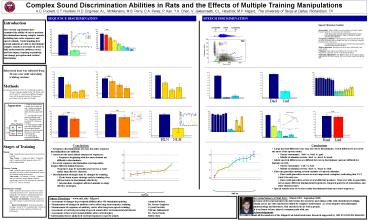36x60 poster template - PowerPoint PPT Presentation
1 / 1
Title:
36x60 poster template
Description:
Recording: Monosyllabic words spoken by female native English speaker in a sound-proof chamber. ... Onsets/consonants: /rad/ vs. /lad/ Middle of stimulus/vowels: ... – PowerPoint PPT presentation
Number of Views:36
Avg rating:3.0/5.0
Title: 36x60 poster template
1
Complex Sound Discrimination Abilities in Rats
and the Effects of Multiple Training
Manipulations A.C. Puckett, C.T. Novitski, N.D.
Engineer, A.L. McMenamy, M.S. Perry, C.A. Perez,
P. Kan, Y.H. Chen, V. Jakkamsetti, C.L. Heydrick,
M.P. Kilgard, The University of Texas at Dallas,
Richardson, TX
SPEECH DISCRIMINATION
SEQUENCE DISCRIMINATION
Introduction The current experiments have
examined the ability of rats to perform
discriminations among complex sounds, including
tone-noise sequences and speech stimuli.
Understanding how normal animals are able to
discriminate complex sounds is necessary in order
to fully understand the auditory cortex and how
injury, learning or plasticity can change
perception and cortical functioning.
- Speech Stimulus Creation
- Recording Monosyllabic words spoken by female
native English speaker in a sound-proof chamber. - The words dad and tad were recorded from 5
other native English speakers (3 male, 2 female)
to assess speaker generalization. - Frequency shifting The frequency of the
fundamental and all other formants were shifted
into the rats hearing range by doubling their
frequency. - Compressed versions of dad and tad were
generated to assess temporal generalization. - Noise reduction Background noise was subtracted
from each signal. - Filtering Each signal was filtered to correct
for the frequency-response curve of the booth
speaker. - Intensity adjustment The RMS-values of the
signals were adjusted so that the loudest 100 ms
of each vowel was 60 dB SPL.
n.s.
- Behavioral data was collected from 46 rats over
4661 total daily training sessions. - Methods
- All animals performed Go/ No-Go discrimination
tasks in the same operant training booths. The
stimuli used as CS and CS- varied among
different training tasks, but the general
timeline of training and procedures were the same
for all tasks.
Dad Tad
HLN NLH
Rad Lad
- Conclusions
- Large spectral differences are easy for rats to
discriminate, even if differences are not in the
onset of the speech sound. - Onsets/consonants /dad/ vs. /bad/ /gad/
- Middle of stimulus/vowels /dad/ vs. /deed/
/dood/ - Subtle spectral differences are difficult for
rats to discriminate (and are difficult for
humans as well). - Onsets/consonants /rad/ vs. /lad/
- Middle of stimulus/vowels /dad/ vs. /dead/
/dud/ - Rats can generalize among several variants of a
speech stimulus. - Rats could generalize across several compressed
exemplars, indicating that VOT wasnt the only
cue. - Rats could generalize across several different
speakers. Rats were able to generalize across
many different fundamental frequencies, temporal
patterns of enunciation, and other
idiosyncrasies. - Speech sounds seem to be more easily
discriminated than tone-noise sequences.
- Conclusions
- Frequency discriminations are easy, but other
sequence discriminations are difficult. - Onsets are the most salient elements of
sequences. - Sequences beginning with the same element are
difficult to discriminate. - Reversed sequence discrimination was
impossible, despite different initial elements. - Sequences may be normally processed as a unit
rather than discrete elements. - Discrimination strategies may be changed by
training. - If rats learn a poor strategy early in
training, they will not learn to discriminate
effectively. - Intermediate exemplars allowed animals to adopt
effective strategies.
- Future Directions www.utd.edu/kilgard
- Assessment of changes in perceptual abilities
after NB-stimulation pairing Amanda Puckett - Measurement of changes in auditory cortex after
long-term sequence training Dr. Navzer
Engineer - Measurement of responses of auditory cortex
after long-term speech training Crystal
Novitski - Assessment of cortical processing of speech
sounds after environmental enrichment Vikram
Jakkamsetti - Assessment of loss of perceptual abilities
after cortical injury Dr. Owen Floody - Information theory analysis of cortical
responses to speech sounds Helen Chen































